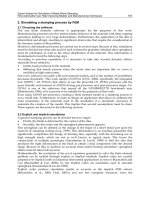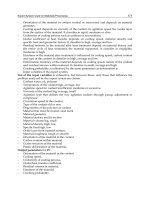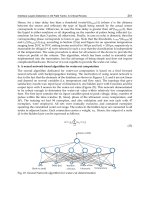Controlled release alginate based microparticulate systems for drug delivery and chemoembolization
Bạn đang xem bản rút gọn của tài liệu. Xem và tải ngay bản đầy đủ của tài liệu tại đây (2.92 MB, 181 trang )
CONTROLLED RELEASE ALGINATE-BASED
MICROPARTICULATE SYSTEMS FOR DRUG
DELIVERY AND CHEMOEMBOLIZATION
LIU XIAOHUA
(B.Sci.(Hons.), SMU)
A THESIS SUBMITTED
FOR THE DEGREE OF DOCTOR OF PHILOSOPHY
DEPARTMENT OF PHARMACY
NATIONAL UNIVERSITY OF SINGAPORE
2008
ACKNOWLEDGMENTS
I wish to express my deepest and most sincere appreciation to my supervisors,
Associate Professor Chan Lai Wah and Associate Professor Paul Heng, for giving
me the chance to work on this topic, the full supervision, the fruitful guidance, and
for the continual support throughout this work.
I am grateful to the National University of Singapore for providing the
research scholarship.
I wish to express my gratitude to Teresa, Mei Yin and Peter for their help in
providing technical support whenever needed. I wish also to express my sincere
gratitude to all my colleagues in GEA-NUS and in the Department of Pharmacy,
who had contributed their time, provided helpful discussions and a friendly
atmosphere for the successful completion of the work. And my thanks to Dr. Li Qi
(Shanghai, China) for his help in animal work.
To my parents, sister and brothers, I offer my sincere gratitude and
appreciation for their support and encouragement over the years of my study. And
my special thanks and appreciation to my wife and my daughter for their
encouragement and patience to complete this work during my stay in Singapore.
i
7$%/(2)&217(176
ĉ
$$OJLQDWHV
$6RXUFHDQGSURGXFWLRQ
$&KHPLFDOVWUXFWXUHDQGDQDO\VLV
$3URSHUWLHV
$$SSOLFDWLRQV
%0LFURVSKHUHVPLFURFDSVXOHVDQGPLFURSDUWLFOHV
%7HFKQLTXHVRIPLFURHQFDSVXODWLRQ
%8VHRISDUWLFXODWHV\VWHPVLQFDQFHUWKHUDS\
ii
&&RQWUROOHGUHOHDVHV\VWHP
&&RQFHSWVRIFRQWUROOHGUHOHDVH
&3RO\PHUVXVHGLQFRQWUROOHGUHOHDVHGHOLYHU\V\VWHPV
&'UXJUHOHDVHPHFKDQLVPVRIFRQWUROOHGUHOHDVHGHOLYHU\V\VWHP
'3RWHQWLDOXVHRIFRQWUROOHGUHOHDVHDOJLQDWHPLFURVSKHUHVLQWUDQVDUWHULDO
FKHPRHPEROL]DWLRQ
Ċ
ċ
$ 0DWHULDOV
$&KHPLFDOV
$0RGHOGUXJV
$&HOOFXOWXUHVDQGUHODWHGPDWHULDOV
$7HVWDQLPDOVDQGUHODWHGPDWHULDOV
% 0HWKRGV
%3UHSDUDWLRQRIDOJLQDWHPLFURVSKHUHVDVFRUHSDUWLFOHVIRUOLTXLGSKDVH
FRDWLQJ
%/LTXLGSKDVHFRDWLQJRIDOJLQDWHPLFURVSKHUHV
iii
%6WXG\RIDOJLQDWHPLFURVSKHUHVIRUDSSOLFDWLRQDVDFKHPRHPEROL]DWLRQ
DJHQW
%3UHSDUDWLRQRI3/*$DOJLQDWHPLFURVSKHUHV
%'HWHUPLQDWLRQRIPRUSKRORJ\DQGVL]HGLVWULEXWLRQRIPLFURVSKHUHV
%'HWHUPLQDWLRQRIGUXJFRQWHQWRIPLFURVSKHUHV
%'UXJUHOHDVHVWXGLHV
% GHJUDGDWLRQVWXGLHV
%(YDOXDWLRQRIJURZWKLQKLELWRU\HIIHFWRIQRUFDQWKDULGLQORDGHG
PLFURVSKHUHVRQOLYHUFDQFHUFHOOOLQH
%(YDOXDWLRQRIDOJLQDWHPLFURVSKHUHVIRUKHSDWLFHPEROL]DWLRQLQUDEELWV
%3KDUPDFRNLQHWLFVDQGWLVVXHGLVWULEXWLRQ
iv
%3KDUPDFRG\QDPLFVVWXG\
& 0DWKHPDWLFDOPRGHOVDQGVWDWLVWLFDODQDO\VLV
&0DWKHPDWLFDOPRGHOV
&6WDWLVWLFDODQDO\VLV
Č
&RDWLQJSURFHVV
3DUWLFOHVL]HDQGGUXJHQFDSVXODWLRQHIILFLHQF\RIWKHFRDWHGPLFURVSKHUHV
(IIHFWRIS+RQGUXJUHOHDVHIURPFRDWHGPLFURVSKHUHV
'UXJUHOHDVHEHKDYLRURIFRDWHGPLFURVSKHUHVLQFKDQJLQJS+FRQGLWLRQ
.LQHWLFVRIGUXJUHOHDVH
6XPPDU\RI3DUWRIVWXG\
9DOLGDWLRQRI+3/&DVVD\RIQRUFDQWKDULGLQ
v
,QIOXHQFHRIFRQWLQXRXVSKDVHRQWKHSURGXFWLRQRIDOJLQDWHPLFURVSKHUHV
,QIOXHQFHRIVXUIDFWDQWRQWKHSURGXFWLRQRIDOJLQDWHPLFURVSKHUHVZLWK
HWK\ODFHWDWH
,QIOXHQFHRIVWLUULQJVSHHGRQWKHSURGXFWLRQRIDOJLQDWHPLFURVSKHUHV
,QIOXHQFHRIGUXJSURSHUWLHVRQWKHSURGXFWLRQRIDOJLQDWHPLFURVSKHUHV
XVLQJLVRRFWDQH
'UXJUHOHDVHIURPDOJLQDWHPLFURVSKHUHV
GHJUDGDWLRQVWXGLHVRIDOJLQDWHPLFURVSKHUHV
*URZWKLQKLELWRU\HIIHFWRIQRUFDQWKDULGLQORDGHGDOJLQDWHPLFURVSKHUHV
RQOLYHUFDQFHUFHOOV
(YDOXDWLRQRIEODQNDOJLQDWHPLFURVSKHUHVIRUKHSDWLFHPEROL]DWLRQLQ
UDEELWV
6XPPDU\RI3DUWRIVWXG\
&RPSDULVRQRIPLFURVSKHUHVSURGXFHGUHVSHFWLYHO\IURPDOJLQDWH3/*$
DQGWKHLUEOHQG
,QIOXHQFHRIIRUPXODWLRQIDFWRUVRQWKHSURGXFWLRQRI3/*$DOJLQDWH
PLFURVSKHUHV
6WXG\RIWKHLPSDFWRIVHOHFWHGIRUPXODWLRQDQGSURFHVVSDUDPHWHUVE\
RUWKRJRQDOGHVLJQ
vi
GUXJUHOHDVHIURP3/*$DOJLQDWHPLFURVSKHUHV
'HJUDGDWLRQWLPHRI3/*$DOJLQDWHPLFURVSKHUHV
*URZWKLQKLELWRU\HIIHFWRIQRUFDQWKDULGLQORDGHG3/*$DOJLQDWH
PLFURVSKHUHVRQOLYHUFDQFHUFHOOV
6XPPDU\RI3DUWRIVWXG\
3UHSDUDWLRQDQGFKDUDFWHUL]DWLRQRI
,ODEHOOHGEURPLQHVXEVWLWXWHG
QRUFDQWKDULGLQ
7KHSKDUPDFRNLQHWLFVRIQRUFDQWKDULGLQORDGHG3/*$DOJLQDWH
PLFURVSKHUHV
7LVVXHGLVWULEXWLRQRIQRUFDQWKDULGLQORDGHG3/*$DOJLQDWHPLFURVSKHUHV
7KHUDSHXWLFHIILFDF\RIQRUFDQWKDULGLQORDGHG3/*$DOJLQDWH
PLFURVSKHUHVRQUDWVEHDULQJWUDQVSODQWHGKHSDWRPD
6XPPDU\RI3DUWRI6WXG\
č
Ď
ď
Đ
vii
SUMMARY
Interest in the formulation of dosage forms to control drug release has
increased steadily in the last 50 years. In most cases, the purpose is to make a
product that is able to produce a prolonged therapeutic effect at reduced dosing
frequency. A large number of substances demonstrate pharmacological effects in
vitro. However, in order to be useful, the active pharmaceutical ingredients (APIs)
must reach the site of action in a concentration large enough to initiate a
pharmacological response. APIs are almost never administered to a patient in an
unformulated state. A dosage form generally consists of one or more APIs, in
combination with a number of other substances (excipients) that are added to
facilitate the preparation and administration, to promote the consistent release and
bioavailability of the API, and to protect the API from degradation. The excipients
strongly influence the physicochemical characteristics of the final product. The
successful formulation of a stable and effective dosage form therefore depends on
the careful selection of excipients. The use of polymers in the formulation of
controlled drug delivery systems has over the years become an important area of
research and development. The present trend points to an increasing interest in the
use of natural ingredients in food, drugs and cosmetics. This is partly attributed to
greater acceptance by consumers for natural ingredients over synthetic materials
(Bhardwaj et al., 2000).
The naturally occurring alginate polymers have been widely used in
pharmaceutical products due to their unique properties. Alginates were first
viii
isolated from seaweeds over a century ago and are now one of the most well
established hydrocolloids in the market. They cover a wide range of applications
in the food and industrial sectors as a result of their thickening and gelling
properties. Alginates contain two different monosaccharide residues,
ȕ-D-mannuronate (M for short) and Į-L-guluronate (G for short), linked randomly
by ȕ-1,4 and Į-1,4 glycosidic bonds. Sodium alginate, which is available
commercially, is used primarily for its ability to form an insoluble gel in contact
with most divalent cations. The ability to easily form an insoluble matrix has made
alginate a useful carrier for the entrapment of cells and drugs (Wee and Gombotz,
1998). However, some limitations are encountered with the use of alginate
microspheres, such as rapid drug release. Drug release from calcium alginate
microspheres is generally fast. More than 90% of sulphaguanidine, with aqueous
solubility of 1:1000 at 25ºC, was released from calcium alginate microspheres
within 1 hour of dissolution test. This was attributed to the high porosity of the
alginate matrix and large specific surface area of the microspheres for drug release
(Wan et al., 1992).
In recent years, various strategies have been employed to solve the
problem of rapid drug release. A key consideration in the modification of drug
delivery systems is the controlled release of drug at the site of action. For example,
additives such as cellulose derivatives have been employed to modify drug release
from alginate matrices (Chan and Heng, 1998). In some studies, drug release was
modified by employing polycations, such as chitosan and poly-L-lysine (PLL) to
form a polyelectrolyte complex (PEC) with alginate (Chang et al., 1999). However,
the above studies showed limited success in sustaining drug release from alginate
ix
matrices. Therefore, this thesis aims to explore other strategies to develop
controlled release alginate microspheres.
The alginate microspheres in this study were prepared by an emulsification
method using model drugs. The emulsifier and stirring rate were found to play
important roles in the preparation and characteristics of the products obtained.
Microspheres of increasing size could be obtained by decreasing stirring rate.
Hence, the first strategy was to employ particle size to control drug release.
However, this was met with limited success as drug release was retarded to a small
extent.
The second strategy employed a liquid phase coating technique to produce
polymer-reinforced alginate microspheres. This technique enabled marked
reduction in drug loss from the microsphere cores to the continuous liquid phase
during coating. In this study, polymethyl methacrylate and poly (lactic-co-glycolic)
acid were employed as coating polymers. The microspheres coated with
polymethyl methacrylate showed markedly lower rate of drug release compared to
the non-coated ones. The release mechanism and rate were affected by the type of
polymethyl methacrylate, core:coat ratio and dissolution media used. Coating with
poly (lactic-co-glycolic) acid was met with limited success. Nevertheless, the
liquid phase coating technique developed offers an efficient method of coating
microspheres with markedly reduced drug loss and possible controlled drug
release.
It is widely known that poly (lactic-co-glycolic) acid (PLGA) is able to
sustain drug release for a prolonged period of time and is therefore not suitable
where relatively fast drug release is desired. On the contrary, drug release from
x
alginate matrix is relatively fast. Hence, the third strategy employed a
double-emulsion method to combine PLGA with alginate to moderate drug release.
Discrete and spherical microspheres containing norcantharidin were successfully
produced. The particle size of the microspheres could be controlled by varying the
stirring rate employed. Reduction of stirring rate resulted in large microspheres.
Drug release rate of the microspheres was dependent on the relative proportion of
PLGA to alginate. Hence, drug release could be controlled by varying the
proportions of these two components in the matrix.
The PLGA-alginate microspheres containing norcantharidin were found to
be promising chemoembolization agents for the treatment of liver cancer. The
microspheres inhibited the growth of liver cancer cells in in vitro studies. The
inhibitory effect was dependent on both concentration of microspheres and contact
time. The microspheres also exhibited embolization of hepatic arteries in rats. In
addition, they markedly increased the survival time of rats with transplanted
hepatoma.
xi
/,672)7$%/(6
xii
xiii
/,672)),*85(6
xiv
xv
ƻ ƶ
xvi
LIST OF ABBREVIATIONS
API active pharmaceutical ingredient
BPAM blank PLGA-alginate microsphere
BSN bromine-substituted norcantharidin
DCM dichloromethane
DDS drug delivery system
EA ethyl acetate
GI gastro-intestinal
HLB hydrophile-lipophile balance
HPLC high-performance liquid chromatography
INPAM
125
I-labeled BSN-loaded PLGA-alginate microsphere
NPAM norcantharidin-loaded PLGA-alginate microsphere
PAMS PLGA-alginate microsphere
PBS phosphate buffer solution
PEC polyelectrolyte complex
PLGA poly (lactic-co-glycolic) acid
PLL poly-L-lysine
PMMA polymethyl methacrylate
PVA poly(vinyl alcohol)
SEM scanning electron microscope
SGF simulated gastric fluid
SIF simulated intestinal fluid
TACE transarterial chemoembolization
xvii
INTRODUCTION
I. Introduction
The naturally occurring alginates can be used to formulate
pharmaceutical products due to their unique properties. A potential application is
the use of alginate as particulate carriers for active pharmaceutical ingredients
(APIs). For example, alginate microspheres had been developed as a drug delivery
system (DDS) for many peptide and protein drugs (Chan and Heng, 1998). An
ideal DDS is able to control the drug concentration at the target site for a desired
period of time. In this section, the properties and applications of alginates,
microparticles and controlled release systems will be discussed.
A. Alginates
Alginates are polysaccharides obtained from brown seaweeds. They have
been widely used in the food and pharmaceutical industries. Traditionally, sodium
alginate has been used as a tablet binding agent, as well as a tablet disintegrant in
compressed tablets (Wan and Heng, 1987). Alginates have also been employed in
the production of capsule shells for medicaments (Narayani and Rao, 1995). These
afore-mentioned applications generally depended on the thickening, gelling and
stabilizing properties of alginates. The ability of alginates to form an insoluble
matrix easily has made them useful carriers for the entrapment of cells and drugs.
A1 Source and production
Alginate was first isolated from seaweeds in 1883 by E. C. Stanfort, a
British pharmacist.
Commercial alginates are extracted primarily from three
1
INTRODUCTION
species of brown seaweeds, namely Laminaria hyperborea, Ascophyllum nodosum,
and Macrocystis pyrifera. Other alginate sources include Laminaria japonica,
Eclonia maxima, Lesonia negrescens and Sargassum species (Smidsrod and
Skjak-Braek, 1990). The alginates form the major structures of the cell wall of
brown seaweeds contributing up to 40% of the total dry matter (Sutherland, 1991).
They are present as mixed salts of sodium, potassium, calcium and magnesium,
with the exact composition varying with the species of seaweeds (Cook, 1986).
Interestingly, alginates are also produced by certain bacteria, such as Azetobacter
vinelandii (Sabra et al., 2001).
The seaweeds grow in abundance on rocky shores. They are harvested
and washed before drying and milling. Alginates are then extracted by heating the
milled seaweed in mild alkali to convert the insoluble alginates in the seaweed to a
soluble form. The alginate extract is filtered and further purified by precipitation
with acid or calcium salt before it is finally converted to the soluble sodium
alginate (Sherbrock-Cox et al., 1984).
A2 Chemical structure and analysis
Alginates belong to a family of linear unbranched polyelectrolyte
copolymers comprising ȕ-(1,4)-linked D-mannuronate (M) and Į-(1,4)-linked
L-guluronate (G) residues. Figure 1 shows the molecular structures of
mannuronate and guluronate residues and their binding to form the polymer.
2
INTRODUCTION
D-mannuronate
L- guluronate
Figure 1 Molecular structures of D-mannuronate and L-guluronate residues and
their binding to form the alginate polymer (adapted from ref. 23).
Alginates may be prepared in a wide range of average molecular weights
(50 to 100 000 residues). The residues have been found to be arranged in three
distinct types of segments: polymannuronate blocks (-M-M-M-), polyguluronate
3
INTRODUCTION
4
blocks (-G-G-G-) and mixed blocks (-M-G-M-G-). The number and length of the
blocks determine the physical properties of the alginates (Kennedy and White,
1988).
High-field
1
H and
13
C NMR spectroscopy was employed for
characterizing alginate (Johnson et al., 1997). Using this technique, the
monomer compositions, as well as the frequencies of the four possible diad
structures (FGG, FMG, FMM and FGM) were determined. Circular dichroism
spectroscopy was also used to match the linear spectra of the alginate to model
samples of well-characterized homopolymeric blocks (Krishna and Sharma, 1991;
Donati et al., 2003).
Figure 2 Different types of alginate conformations: (a) poly-ȕ-(1,4)-linked
D-mannuronate segment; (b) poly-Į-(1,4)-linked L-guluronate
segment; and (c) alternating poly-Į-(1,4)-linked L-guluronate-
ȕ-(1,4)-linked D-mannuronate segment (adapted from ref. 23).
INTRODUCTION
The crystalline structures of polymannuronate and polyguluronate
segments were studied by X-ray diffraction and polarized infrared spectroscopy
(Sherbrock-Cox et al., 1984; Anastassiadou et al., 1996). The polymannuronate
segment was found to exist as a flat ribbon-like structure (Figure 2a), while the
polyguluronate segment was buckled and ribbon-like (Figure 2b). The ribbon-like
conformation is stabilized by intramolecular hydrogen bond between the hydroxyl
group and the oxygen atom of the carboxyl group of adjacent units. Alternating
poly Į-(1,4)-linked L-guluronate-ȕ-(1,4)-linked D-mannuronate contains both
equatorial-axial and axial-equatorial links that result in a disorderly conformation.
In this conformation, hydrogen bonds are formed between the carboxyl group of
the mannuronate and the hydroxyl groups in the 2- and the 3-positions of the
adjacent guluronate. Chaplin found that the overall flexibility of the mixed
segment was greater than that of the poly ȕ-(1,4)-linked D-mannuronate segment
due to differences in the degree of freedom of the two residues (Figure 2c).
The amount of each component (M and G) depend on the species of
seaweed, the condition of growth and the part of the seaweeds (stalk or leaf) from
which the alginate is derived. Table 1 lists the various sources of alginates and
their compositions. It was reported that the content of L-guluronate increased as
the tissue became older and tougher (Taha and Aiedeh, 2000).
5
INTRODUCTION
6
INTRODUCTION
7
A3 Properties
A3.1 Physical properties
Alginic acid is insoluble in water but swells on contact with an aqueous
medium. The water-soluble form of alginate is made by neutralizing alginic acid
with sodium or potassium salts. The water-insoluble forms include alginate salts of
multivalent ions such as calcium, lead and chromium.
The flexibility of the alginate polymers in solution increases in the
following order: MG>MM>GG. Alginate gels with the lowest shrinkage, highest
porosity, and best stability towards monovalent cations are made from alginates
with a guluronate content greater than 70% and an average length of
polyguluronate block greater than 15. The gels made from these "high G"
alginates are rigid and brittle (Wandrey et al., 2003; Draget et al., 2003).
Alginates dissolve in both hot and cold water to give solutions with a
wide range of unusually high apparent viscosities, even at 1% solute concentration
for some grades, due to their high molecular weight and rigid structure (Kennedy
and White, 1988). The viscosity of alginate solution increases logarithmically with
its concentration (Gan and Lin, 1997). Addition of water-miscible solvents, such
as alcohols, glycols or acetone, increases the viscosity of the alginate solution and
upon reaching a certain concentration, the alginate will precipitate. The various
alkaline solutions of alginate are tasteless and almost colourless. Alginates are
very useful especially in food products because they are natural polymers of plant
and not animal origin and are readily available. They are non-calorific and safe for
consumption.









